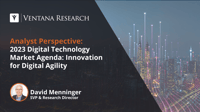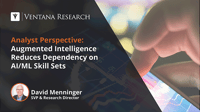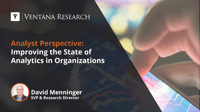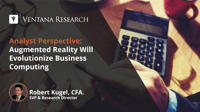A lot has been written about the definition of generative artificial intelligence (AI) and large language models (LLMs), though less has been written about the business considerations for an organization to evaluate adopting and implementing these technologies. And more importantly, does the technology align with the Office of the CIO objectives and the goals of the business? The value of generative AI software must be put into terms that all stakeholders can relate to. And organizations cannot...
Read More
Topics:
Digital Technology,
natural language processing,
AI & Machine Learning,
Collaborative & Conversational Computing
In my perspective on decision intelligence, I lamented the fact that business intelligence technologies have left the rest of the exercise to the reader for too long. Making a decision is a process that involves many steps and many people. Decision-making is so complicated and divorced from day-to-day business processes that organizations have had to create entirely separate teams to focus on the analytics and data to support it. One aspect of the decision-making process that can be enhanced by...
Read More
Topics:
business intelligence,
Analytics,
Digital Technology,
Analytics & Data,
Collaborative & Conversational Computing
Ventana Research recently announced its 2023 Market Agenda for Analytics, continuing the guidance we have offered for nearly two decades to help organizations derive optimal value from technology investments to improve business outcomes.
Read More
Topics:
embedded analytics,
Analytics,
Business Intelligence,
Data,
Digital Technology,
natural language processing,
Process Mining,
Analytics & Data,
Collaborative & Conversational Computing
I’m proud to share Ventana Research’s 2023 Market Agenda for Digital Technology. Our focus in this agenda is to deliver expertise to help organizations prioritize technology investments that improve customer, partner and workforce experiences while also increasing organizational effectiveness and agility.
Read More
Topics:
Analytics,
Cloud Computing,
Internet of Things,
Data,
Digital Technology,
blockchain,
mobile computing,
extended reality,
AI & Machine Learning,
robotic automation,
Collaborative & Conversational Computing
Business intelligence has evolved. It now includes a spectrum of analytics, one of the most promising of which has been described as augmented intelligence. Some organizations have used the term to describe the practical reality that artificial intelligence with machine learning is not replacing human intelligence, but augmenting it. The term also represents the application of AI/ML to make business intelligence and analytics tools more powerful and easier to use. It’s this latter usage that I...
Read More
Topics:
Analytics,
Business Intelligence,
natural language processing,
AI & Machine Learning,
Analytics & Data,
Collaborative & Conversational Computing
Despite all the advances organizations have made with respect to analytics, our most recent research shows the majority of the workforce in the majority of organizations are not using analytics and business intelligence (BI). Less than one-quarter (23%) report that one-half or more of their workforce is using analytics and BI. This is a problem. It means organizations are not enabling their workforce to perform at peak efficiency and effectiveness. It means the workforce in many organizations...
Read More
Topics:
Sales,
business intelligence,
embedded analytics,
Analytics,
Data,
Sales Performance Management,
Digital Technology,
Digital Commerce,
natural language processing,
Subscription Management,
partner management,
Revenue Management,
Sales Engagement,
Collaborative & Conversational Computing
Ventana Research recently announced its 2022 Market Agenda for Analytics, continuing the guidance we have offered for nearly two decades to help organizations derive optimal value from technology investments in order to improve business outcomes.
Read More
Topics:
embedded analytics,
Analytics,
Business Intelligence,
Digital Technology,
natural language processing,
Process Mining,
Analytics & Data,
Collaborative & Conversational Computing
As with many IT innovations, augmented reality (AR), extended reality (XR) and the related topic of spatial computing had been discussed to death long before they became a practical reality. As a user interface, AR is already well understood in terms of its ability to open vast new vistas in entertainment as well as making physical tasks, such as machinery maintenance and warehouse pick-and-pack, far more efficient. In the case of spatial computing, by using glasses to superimpose workflow...
Read More
Topics:
Office of Finance,
Digital transformation,
natural language processing,
extended reality,
Digital Business,
robotic automation,
Collaborative & Conversational Computing
















